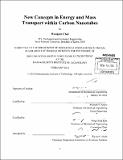New concepts in energy and mass transport within carbon nanotubes
Author(s)
Choi, Wonjoon, Ph. D. Massachusetts Institute of Technology
DownloadFull printable version (26.68Mb)
Other Contributors
Massachusetts Institute of Technology. Dept. of Mechanical Engineering.
Advisor
Michael S. Strano.
Terms of use
Metadata
Show full item recordAbstract
The unique structure of carbon nanotubes (CNTs) contributes to their distinguished properties, making them useful in nanotechnology. CNTs have been explored for energy transport in next-generation, such as light-emitting diodes, field-effect transistors, and phonon wave guides due to their high axial electrical and thermal conductivity. Also, their subnanometer scale with atomically smooth surfaces is promising for selective mass transport in nanoscale, such as molecular transport, selective gas permeation, and nanofluidics. The first part of this thesis considers CNTs as substrates for guided chemical reactivity and thermal waves for energy generation. Coupling an exothermic chemical reaction with a nanowire possessing a high axial thermal conductivity creates a self-propagating reactive wave. Such waves are realized using a 7-nm cyclotrimethylene-trinitramine (TNA) annular shell around a CNT and are amplified by 104 times the bulk TNA value, propagating more than 2 m/s, with an effective thermal conductivity of 1.28 ± 0.2 kW/m/K at 2860 K. Thermally excited carriers in the direction of the propagating reaction produces a concomitant electrical pulse of high specific power, as large as 7 kW/kg, that we identify as a thermopower wave. The specific power increases with a decreasing system size, resulting in usually efficient sub-micron and nano-sized pulse power sources. In the second portion, we develop a nanopore platform using the interior of a single walled carbon nanotube (SWNT) for study of single ion transport. Such pores can undergo a resonance in ion transport such that coherent waveforms are generated (CR). The asymmetric electrostatic barriers at their ends show that above the threshold bias, traversing the nanopore end is not rate limiting and that the pore blocking behavior of two parallel nanotubes follows an idealized Markov process. We report two channels undergoing this CR simultaneously, the dynamics of ion transport for different cations (Li+, Na+, K+, Cs+) and the effect of varying the applied voltage on transport across the SWNT channel. Finally, the diameter and temperature dependence (1-2 nm) of ion transport shows the distinct trend in dwell time and blockade current that study its transfer mechanism by proton 'hop' and 'turn', and single ion transport.
Description
Thesis (Ph. D.)--Massachusetts Institute of Technology, Dept. of Mechanical Engineering, 2012. Cataloged from PDF version of thesis. Includes bibliographical references (p. 164-177).
Date issued
2012Department
Massachusetts Institute of Technology. Department of Mechanical EngineeringPublisher
Massachusetts Institute of Technology
Keywords
Mechanical Engineering.